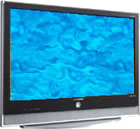Which TV is Best:
LCD, Plasma, DLP, LCoS or LCD Rear Projection?
LCoS Front or Rear Projection TV ...continued from page 1
With LCoS, pixel edges tend to be softer or smoother, as compared to the sharp edges of DLP pixels, This yields a more natural, film-like image. Although some people prefer the sharpness of DLP. This is more of a personal preference factor. However, in our opinion, achievement of a film-like image is the true goal that any TV should be shooting for.
In most cases the light bulb inside is designed to be replaced (this is also true for DLP and LCD models. Being seen more often, is a bulb replaceable by the user; saving the cost of a service call. Bulb lifespans vary by manufacturer, but expect about 4,000 hours for RPTVs and 1,500 hours for projectors.
LCoS can be implemented differently by manufacturer. Sony calls their version SXRD (Silicon X-tal Reflective Display), JVC's version is D-ILA (Direct-drive Image Light Amplifier). While using the underlying technology may be the same, viewers may have a preference for one manufacturers implementation over another. Currently, there is empirical reason to choose one over another.
Intel has closed down their LCoS development because of problems they encountered. However, that doesn't spell doom for this promising technology, it just opens up the field to smaller technology companies who don't have to fear Intel dominating the market. As production increases, prices will decline. As the cost comes down, and in light of the clearly better picture, LCoS should become an obvious choice for consumers.
| Pluses: | Minuses: |
|
|
Back to previous page...Page 1
|
||||
Section 1: DLP Rear Projection
Section 2: LCD Rear Projection
Section 3: LCoS Rear Projection





